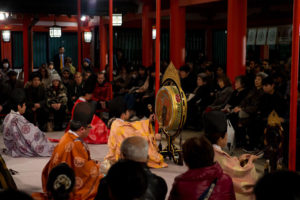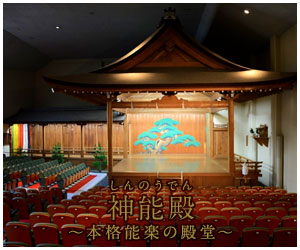雅楽について
雅楽 GAGAKU
一般財団法人 日本雅楽協会
~雅楽について~
雅楽(ががく)
日本固有の歌舞(現行では神楽、東遊、倭舞、久米舞等)、平安朝頃の歌謡(催馬楽、朗詠等)、外来音楽(現行では唐楽、高麗楽の二系統の楽舞)等を総称して雅楽という。
六世紀前半より、主に中国大陸より日本に伝えられ受け継がれている。 現存する日本の最古の音楽です。 音楽として楽しむ演奏はもちろんですが、結婚式などのお祝いで演奏をされます。
~GAGAKU Appreciation~
About GAGAKU (雅楽)
Gagaku is a Japanese Imperial Court Music & Dance. It was originally brought to Japan from the Chinese continent, and it has been recognized as the oldest surviving music in Japan. It’s enjoyed as a music and also performed at the ceremonies such as wedding receptions. The Gagaku repertory today consists of the following categories: Instrumental ensemble (KANGEN) and Dance music (BUGAKU)
管絃(かんげん)
現行では三管(鳳笙・篳篥・龍笛)、三鼓(鞨鼓・太鼓・鉦鼓)、二絃(楽琵琶・楽箏)で演奏する器楽合奏を指す。 楽曲は「唐楽」に限定されている。 基本、天皇や貴族が演奏を楽しむモノ(「御遊=遊び」)であり、古くは「和琴」も用いていた。
管絃という演奏形体では、鞨鼓(かっこ)・太鼓(たいこ)・鉦鼓(しょうこ)の三つの打楽器と、楽琵琶(がくびわ)・楽箏(がくそう)の二つの絃楽器と、笙(しょう)・篳篥(ひちりき)・龍笛(りゅうてき)の管楽器を用います。
KANGEN(管絃)
KANGEN is an instrumental music. Three kinds of wind instruments such as Sho, Hichiriki and Ryuteki, two kinds of string instruments such as Gakubiwa and the Gakuso, and three kinds of percussion instruments such as Kakko, Taiko and Shoko are used. In Kangen, Hichiriki (oboe) plays the main line of melody, while the ryuteki (flute) melody parallels it, obbligato style. The lowest note of each chord on the shō follows the key notes of the main melody. The string and percussion instruments are used mostly for rhythm.
笙(しょう)
吹き口の付いた木製の匏(つぼ)に十七本の竹管を差し、帯金具で締めて固定した管楽器。 十七本の竹の内、十五本が音を奏で、全長約五〇センチで、竹管の下部に簧(した)と呼ぶリード、その上に音を出す指孔、さらにその上部に簧の振動と共鳴する屏上(びょうじょう)という孔がある。 口の手前で引き寄せるように構え、指孔を押さえたり離したりしながら、吹き口を吹いたり吸ったりして演奏する。 内部は湿りがちで乾燥させなければよい音がでないため、匏(つぼ)の下方を炭火であぶって調整しておく。
「合竹(あいたけ)」という五、六音の和音を奏でる。
SHO(笙)
Instrument made from seventeen pieces of bamboo inserted into a small jar. It is used to produce a chord like sound.
篳篥(ひちりき)
竹製で、全長約一八センチ。 指孔は表に七つ、裏に二つあり、上端に「廬(ろ)舌(ぜつ)」と呼ばれるダブルリードのリードを差して吹奏する。 大篳篥と小篳篥の二種類があるが、小篳篥が主流。 西域で作られ、わが国には中国から伝来して、演奏の主旋律を奏でる。 音域は一オクターブほど。
HICHIRIKI(篳篥)
Japanese short, double-reed wind instrument. It’s made with a short piece of bamboo and a reed pipe. It is about 18 cm (7 inches) long and has seven finger holes on the front of the instrument. and two thumb holes on the back. It has about one octave range. reed pipe.
龍笛(りゅうてき)
竹製で、全長四〇センチ。 指孔は七つで、吹き口や指孔の部分を除いて、樺皮の紐を巻いて漆を塗り、頭部は安定させるため鉛の重しをつける。 篳篥が主旋律を奏し、龍笛が細かい装飾音を奏でます。音域は二オクターブほど。
RYUTEKI(龍笛)
Japanese transverse flute made of bamboo. It’s about 40 cm long and has seven finger holes on the front of the instrument. It has about two octave range.
舞楽(ぶがく)
雅楽器の伴奏による舞を見て楽しむモノ。 現行では、管楽器と打楽器の伴奏で舞われる。演奏する音楽によって、「左方(左舞)」と「右方(右舞)」に分けられる。 「左舞」は「唐楽」を伴奏にして、管絃の時と同じ楽器編成(鳳笙・篳篥・龍笛・鞨鼓・太鼓・鉦鼓)。「右舞」は「高麗楽」を伴奏にして、鳳笙は使わず、横笛も「高麗笛」を用い、「鞨鼓」の代わりに「三の鼓」を用いる。舞人の装束の色も対比させている。(左方は赤・金、右方は緑・銀)
BUGAKU(舞楽)
BUGAKU is a dance performed with musical accompaniment (wind instrument & percussion instruments.) Depending on the music accompaniement, dance can be divided into either the dance “Sahō no mai (“dances of the left”) or “Uhō no mai (“dances of the right.”) The dance “Sahō no mai” is accompanied by Togaku, and the latter, the dance “U-no-Mai” is accompanied by Komagaku. In Sahō no mai, wind and percussion instruments play the accompaniment, and string instruments are not used; on the other hand, in Uhō no mai, percussion instruments play the accompaniment, and string instruments are never used. The two forms are also differentiated by the color of the dancers’ richly embroidered costumes; Sahō no mai costumes tend to be red or gold, and Uhō no mai to be green or silver.
~演目について~
越天楽(えてんらく)
管絃 平調
管絃曲。 唐楽。 小曲。 早四拍子。 拍子八。 末二拍子加。
現行の中では今回演奏する「平調」の曲が一番有名だが、他に「盤渉調」「黄鐘調」の曲がある。 これらは「渡物」という洋楽で言う移調の関係にあるが、聞いて素直な移調が分かるのは箏だけで、他の楽器はそれぞれの音域の制約のために別な曲に聞こえてしまう。
よく「残楽」という特殊な演奏法や「重頭」という旋律部を使った繰り返しでの演奏が多く見受けられるが、今回は一番シンプルなスタイル(拍子八)で演奏する。
PROGRAMME
GAGAKU ETENRAKU (雅楽 越天楽)
ETENRAKU is a piece of Japanese gagaku melody and dance. There are three pieces with this title in different modes, which are Hyō-jō, Ōshiki-chō and Banshiki-chō. Among them “Etenraku” in the Hyō-jō mode which is the most famous will be performed today.
蘭陵王(らんりょうおう)
舞楽の場合は「陵王」と言い慣わされる。 一人舞。 きらびやかな面の上部には龍が乗っており、毛縁の裲襠装束の前後には丸紋の中に龍の刺繍が四つある。 右手に金色の桴を持ち、左手は検印という形をとる。 舞台上を激しく縦横に舞うので、「走舞」にも分類される。 実在した中国の王である蘭陵王長恭は、才知武勇にして容姿が美しく、味方の兵がその姿に見とれて戦の士気が上がらなかった。 そこで龍を模した仮面を着けた王が黄金の桴を手に味方を鼓舞し、敵を撃ち取り合戦に勝利した。 その様を舞にしたといわれ、舞楽の代表曲であり勝利の舞として大変縁起の良い舞です。
この度の舞振りは、世界文化遺産にも登録される広島県安芸の宮島厳島神社に伝承される舞振りで、神戸に縁の深い平清盛が大阪の四天王寺より厳島神社に伝え、清盛はもちろんの事、毛利元就や豊臣秀吉など名だたる名将に愛されたという勇壮な舞です。
1プレリュード 「小乱声」龍笛音頭と太鼓・鞨鼓 2出手 「陵王乱序」龍笛と打楽器〔龍笛の奏法を「追吹」という〕 3沙陀調音取 三管音頭と鞨鼓 4当曲 「蘭陵王 破」早八拍子。 拍子十六。 5入手 「安摩乱声」龍笛と打楽器〔龍笛の奏法を「退吹」という〕
BUGAKU RANRYOO (舞楽 蘭陵王)
RANRYO-O is also known as “RYOO.” The Solo Dance accompanied by traditional music. Ryo-o is one of the most popular dances of the Bugaku. Dancer wears a mask with decorative dragon on the top and a
costume embroidered with four dragons each in the front and back and holds a gold wooden stick on the
right hand. This tells the story of a Chinese legend of a king who wore a fierce mask on the battlefield to frighten his enemies. This dance was carried onto Itsukushima shrine registered as World Heritage site in Hirosima from Shitenno shrine in Osaka by a warrior, Tairano Kiyomori who had a close relation with KOBE. This dynamic dance was beloved by well-known warriors including Hideyoshi Toyotomi etc.
退出音声 長慶子(まかでおんじょう ちょうけいし)
「退出音声」とは舞楽会の終わりを告げる演奏。 そもそも貴人の退出時に演奏するのがその役割。 長慶子は醍醐帝の皇孫で、博雅三位として有名な源博雅(918~980)の作曲という。
この曲を舞楽吹きで演奏することが多い。 優美且つ闊達なこの曲は、行事の締めくくりとして相応しいと思われる。
GAGAKU CHOUKEISHI (雅楽 長慶子)
This marks the end of Bugaku. It is played when leaving the stage, so this elegant piece is considered as a suitable number for ending the event.








